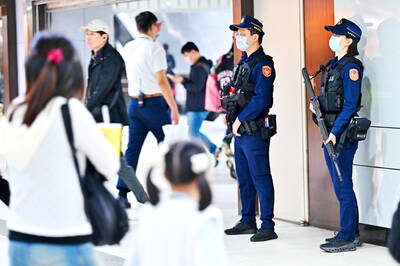The military is to station mobile missile defense systems along Taiwan’s east coast after Chinese military vessels were spotted in the area, a source said yesterday.
On Friday, six Chinese warships, including the aircraft carrier Liaoning, entered the Pacific Ocean via the Miyako Strait, posing a threat to Taiwan’s east coast.
The Japanese Ministry of Defense on Friday confirmed the passage of the ships, saying that its Maritime Self-Defense Force monitored the vessels, adding that they did not enter Japan’s territorial waters.

Photo: Hung Chen-hung, Taipei Times
The source said the vessels were likely headed to the Pacific Ocean for training exercises.
The vessels were identified as the Liaoning with hull number 16, Type 054A guided-missile frigate Zaozhuang with hull number 542, Type 052D guided-missile destroyer Chengdu with hull number 120, Type 055 guided-missile destroyer Anshan with hull number 103, Type 055 guided-missile destroyer Wuxi with hull number 104 and Type 901 supply ship Hulunhu with hull number 901.
The scale and formation of the battle group was rare, the source said, adding that it was likely preparing for aircraft takeoff and landing exercises, and related combat training.
Following the passage, the Ministry of National Defense in Taipei ordered the navy and air force to improve readiness measures on Taiwan’s east coast.
The ministry said that while this was not the first passage by Chinese naval vessels through the Miyako Strait — and although it always monitors such passages and is ready to respond — it was enhancing missile defenses on the east coast as an improved readiness measure.
The military has deployed mobile missile launchers for Hsiung Feng II and Hsiung Feng III anti-ship missiles to eastern Taiwan, the source said, adding that it would also deploy shore-mounted Harpoon missiles procured from the US.
The deployments would be funded by a special budget, and members of the marine corps would take charge of the missile systems, the source said.
Missile systems would be upgraded nationwide, but priority has been given to the east coast, due to a greater risk there, they added.
The Chungshan Institute of Science and Technology would design and supervise missile-system installations, but the exact locations of deployment would not be made public due to security reasons, the source said.
The two Hsiung Feng systems would each have a range of 150km and would later be complemented with Harpoon deployments, which have a range of 250km, the source said.
Fixed military facilities, like those on Hualien County’s Hetianshan (賀田山), would be targets in wartime, which is why it is deploying mobile systems, they added.
The missile upgrade program is expected to be completed in 2026, and training would be conducted on the east coast, where missile-storage and living facilities, as well as a control room, are already in place, they said.

The US government has signed defense cooperation agreements with Japan and the Philippines to boost the deterrence capabilities of countries in the first island chain, a report by the National Security Bureau (NSB) showed. The main countries on the first island chain include the two nations and Taiwan. The bureau is to present the report at a meeting of the legislature’s Foreign Affairs and National Defense Committee tomorrow. The US military has deployed Typhon missile systems to Japan’s Yamaguchi Prefecture and Zambales province in the Philippines during their joint military exercises. It has also installed NMESIS anti-ship systems in Japan’s Okinawa

TRAGEDY STRIKES TAIPEI: The suspect died after falling off a building after he threw smoke grenades into Taipei Main Station and went on a killing spree in Zhongshan A 27-year-old suspect allegedly threw smoke grenades in Taipei Main Station and then proceeded to Zhongshan MRT Station in a random killing spree that resulted in the death of the suspect and two other civilians, and seven injured, including one in critical condition, as of press time last night. The suspect, identified as a man surnamed Chang Wen (張文), allegedly began the attack at Taipei Main Station, the Taipei Fire Department said, adding that it received a report at 5:24pm that smoke grenades had been thrown in the station. One man in his 50s was rushed to hospital after a cardiac arrest

ON ALERT: Taiwan’s partners would issue warnings if China attempted to use Interpol to target Taiwanese, and the global body has mechanisms to prevent it, an official said China has stationed two to four people specializing in Taiwan affairs at its embassies in several democratic countries to monitor and harass Taiwanese, actions that the host nations would not tolerate, National Security Bureau (NSB) Director-General Tsai Ming-yen (蔡明彥) said yesterday. Tsai made the comments at a meeting of the legislature’s Foreign Affairs and National Defense Committee, which asked him and Minister of National Defense Wellington Koo (顧立雄) to report on potential conflicts in the Taiwan Strait and military preparedness. Democratic Progressive Party (DPP) Legislator Michelle Lin (林楚茵) expressed concern that Beijing has posted personnel from China’s Taiwan Affairs Office to its

PUBLIC SAFETY: The premier said that security would be tightened in transport hubs, while President Lai commended the public for their bravery The government is to deploy more police, including rapid response units, in crowded public areas to ensure a swift response to any threats, President William Lai (賴清德) said yesterday after a knife attack killed three people and injured 11 in Taipei the previous day. Lai made the remarks following a briefing by the National Police Agency on the progress of the investigation, saying that the attack underscored the importance of cooperation in public security between the central and local governments. The attack unfolded in the early evening on Friday around Taipei Main Station’s M7 exit and later near the Taipei MRT’s Zhongshan